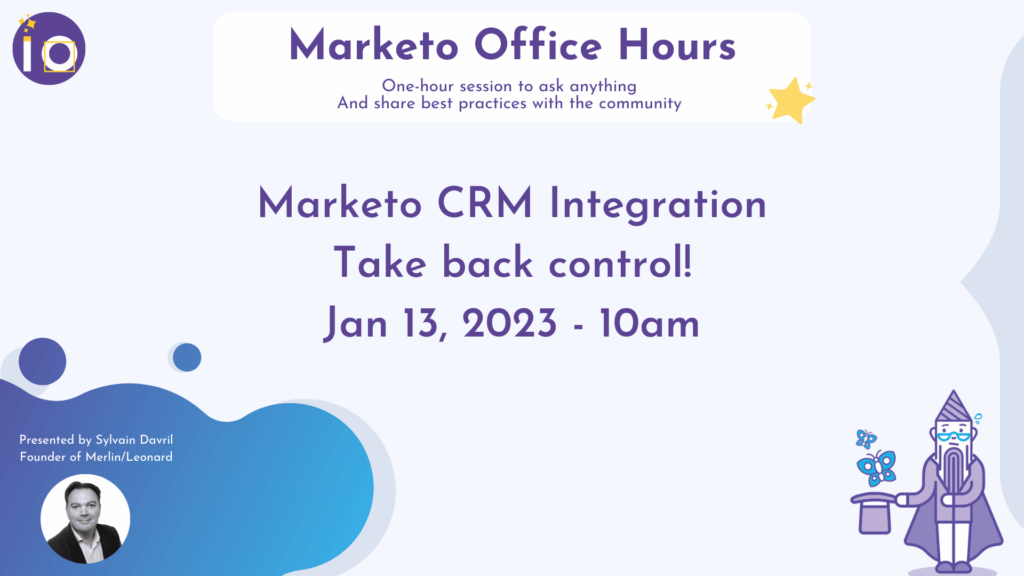Synchronization between Marketo and a CRM is a cornerstone of marketing automation strategy for many companies. This article explores in depth how this integration can transform your approach to marketing and customer relationship management, with a particular focus on “Marketo CRM synchronization”.
Sylvain opens up his Marketing Automation – Marketo – and CRM – Salesforce – to show us the secrets of this native integration, and the best practices for getting the most out of it.
- 00:00 The end-to-end lifecycle. What happens when Marketing Automation is integrated into CRM? Definition of the Qualification / Enrichment / Conversion / Deduplication processes.
- 06:30 The difference between Lead and Contact. Why Marketing prefers to use the Lead to receive information from the Lead.
- 08:30 Question: can we send an alert to sales when a lead is converted?
- 12:25 The Revenue Cycle Model becomes available when synchronization is implemented.
- 13:20 Marketo’s Program Analyzer and Revenue Attribution Engine
- 15:10 The Opportunity Influence Analyzer
- 16:36 How Marketo CRM synchronization works
- 18:50 Impact of synchro on Marketo fields
- 20:30 Question: I have MS dynamics and some fields are not mapped.
- 21:30 Possibility of remapping or merging fields with Marketo support
- 22:08 Choice of default synchronization parameters on the Marketo side
- 24:25 Marketo iframes to insert into CRMs and Interesting moments
- 25:50 Transferring people from MArketo to CRM and the Lead Life Cycle program
- 27:20 Filters, triggers and actions possible in CRM from Marketo thanks to synchro
- 30:00 Impact of partitions on the lead life cycle and scoring
- 31:30 Question: why only one campaign to drive leads to CRM? and key management between Marketo and CRM
- 37:48 Question: what happens if a sales rep adds a person to a Salesforce campaign that is synchronized with Marketo?
- 41:19 Salesforce – Marketo custom object synchronization – Quizzes example
The importance of Marketo CRM synchronization
Synchronization between Marketo and a customer relationship management (CRM) system creates an essential bridge between marketing and sales, enabling a unified view of the customer journey. This integration offers a multitude of benefits, including improved lead qualification, sales and marketing alignment, and optimized marketing campaigns.
How does synchronization work?
Marketo CRM synchronization enables a two-way exchange of information. On the one hand, lead data generated by marketing activities in Marketo is transmitted to the CRM, where it can be used by the sales team for targeted follow-up. On the other, information gathered by the sales team in the CRM can be sent back to Marketo to refine marketing automation strategies.
Benefits of Marketo CRM Synchronization
- Improved lead qualification: By synchronizing lead scores and demographic data from Marketo with the CRM, sales teams can prioritize the hottest leads and increase conversion rates.
- Campaign personalization: Information gathered in the CRM can help personalize Marketo campaigns, ensuring that marketing messages are aligned with the specific needs and interests of each prospect.
- ROI tracking: The integration makes it possible to track the effectiveness of marketing campaigns by directly measuring their impact on sales, making it easier to optimize marketing spend.
Steps to successful synchronization
- System preparation: Before synchronization, it’s crucial to ensure that data fields in Marketo and CRM are correctly mapped, and that data is cleansed to avoid duplication.
- Lead management: Clearly define how leads will be transferred between Marketo and CRM, including qualification criteria and handover processes between marketing and sales teams.
- Monitoring and optimization: Once synchronization has been implemented, it is essential to monitor data flows between systems and continuously optimize processes to maximize efficiency.
Challenges and solutions
While Marketo CRM synchronization offers many benefits, it can also present challenges, particularly in terms of data management and communication between teams. To overcome these obstacles, we recommend establishing clear data management protocols, training teams on synchronization processes, and encouraging close collaboration between marketing and sales departments.
Conclusion
Marketo CRM synchronization is a powerful practice that can significantly improve the effectiveness of your marketing and sales efforts. By ensuring seamless integration between these systems, companies can deliver a consistent, personalized customer experience, increase conversions and accurately measure the ROI of their marketing campaigns. With careful planning and careful execution, Marketo CRM synchronization can become a major strategic lever for your business.















